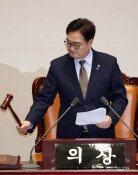Annual Private Education Expenditures Reached 13.6 Trillion Won
Annual Private Education Expenditures Reached 13.6 Trillion Won
Posted November. 19, 2003 23:05,
According to research conducted, annual private education expenditures of elementary, middle and high school students nationwide reached 13.6 trillion won, with one out of every four households spending 30 percent or more of their income on private education.
However, the total expenditures on private education is estimated to be much higher as the private education expenditure of preschool students was not included.
On November 19, the Korean Educational Development Institute released the result of its survey of private education expenditures. The survey was conducted in September and October on 4,588 elementary, middle and high school students, 12,462 parents, and 2,582 teachers nationwide.
According to the survey, the estimated private education expenditures between September 2002 and August 2003 was 13.6485 trillion won. This was an inflation-adjusted increase of 2.5350 trillion won compared with the expenditures in 2001 and more than three trillion won increase without the adjustment.
The expenditure accounted for 2.3 percent of 2002 GDP estimate (591 trillion won) and 54.5 percent of this years Ministry of Education and Human Resources Developments (24.9036 trillion won) total budget.
Monthly private education expenditures per student stood at 238,000 won. In terms of regional differences, per student expenditure amounted to 4.78 million won in the Gangnam area of Seoul, 3.13 million won in other parts of Seoul, 2.76 million won in metropolitan cities, 3.58 million won in Seoul suburban areas, 2.49 million in small and medium sized cities, and 2.03 million won in rural areas.
Among households, 23.5 percent spent 30 percent or more of their income and 3.6 percent spent even more than half of their income on private education.
The survey showed that 72.6 percent of elementary, middle and high school students nationwide received private education and regionally, 75.8 percent of students in Seoul, 74.0 percent in metropolitan cities, 74.2 percent in small and medium sized cities, and 62.1 percent in rural areas.
The most popular form of private education was tutor-assisted home study booklets, representing 38.6 percent, followed by private institute with comprehensive classes, private institute with selective classes, private tutoring, and group tutoring each recording 27.0 percent, 24.4 percent, 14.3 percent, and 10.0 percent, respectively.
Seong-Chul Hong sungchul@donga.com







